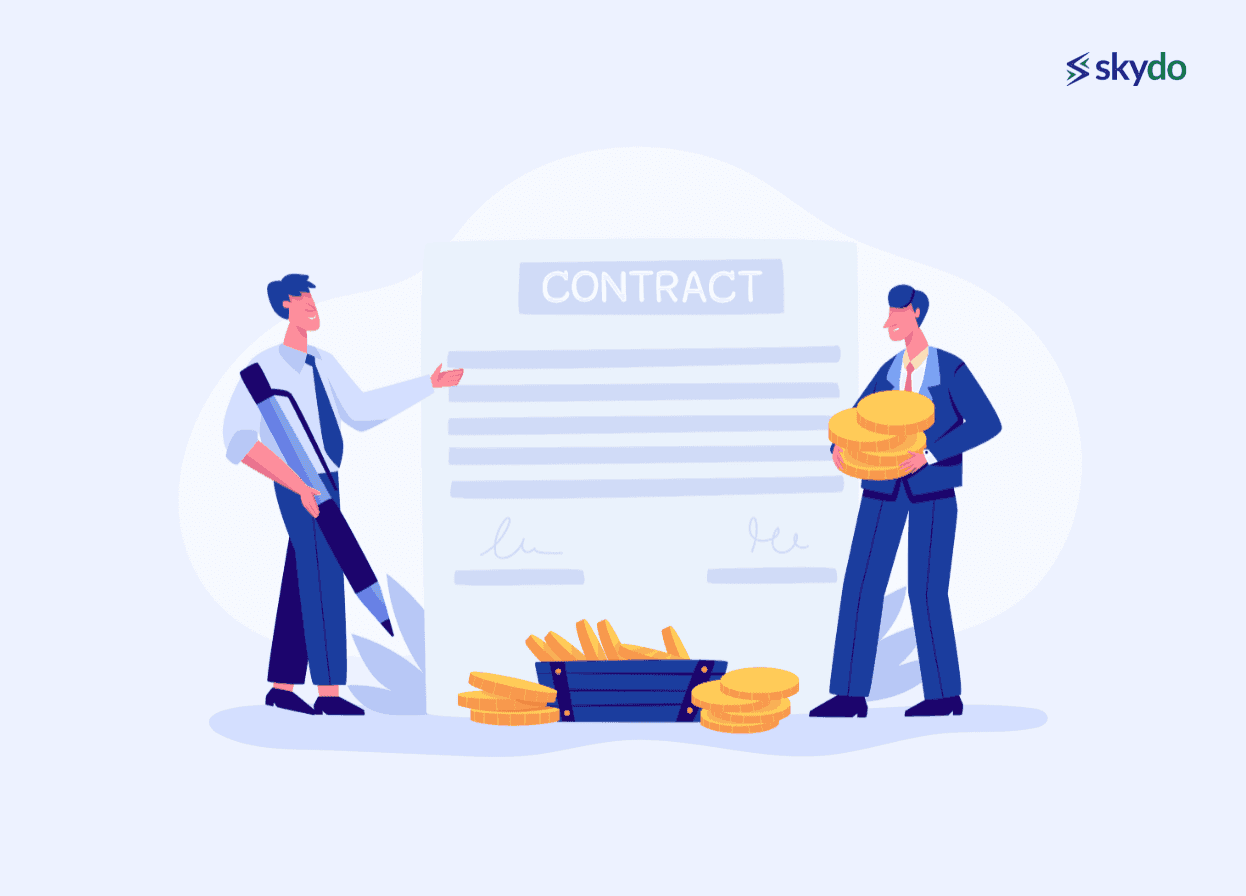How to Safeguard Your Business’ Profit Margins

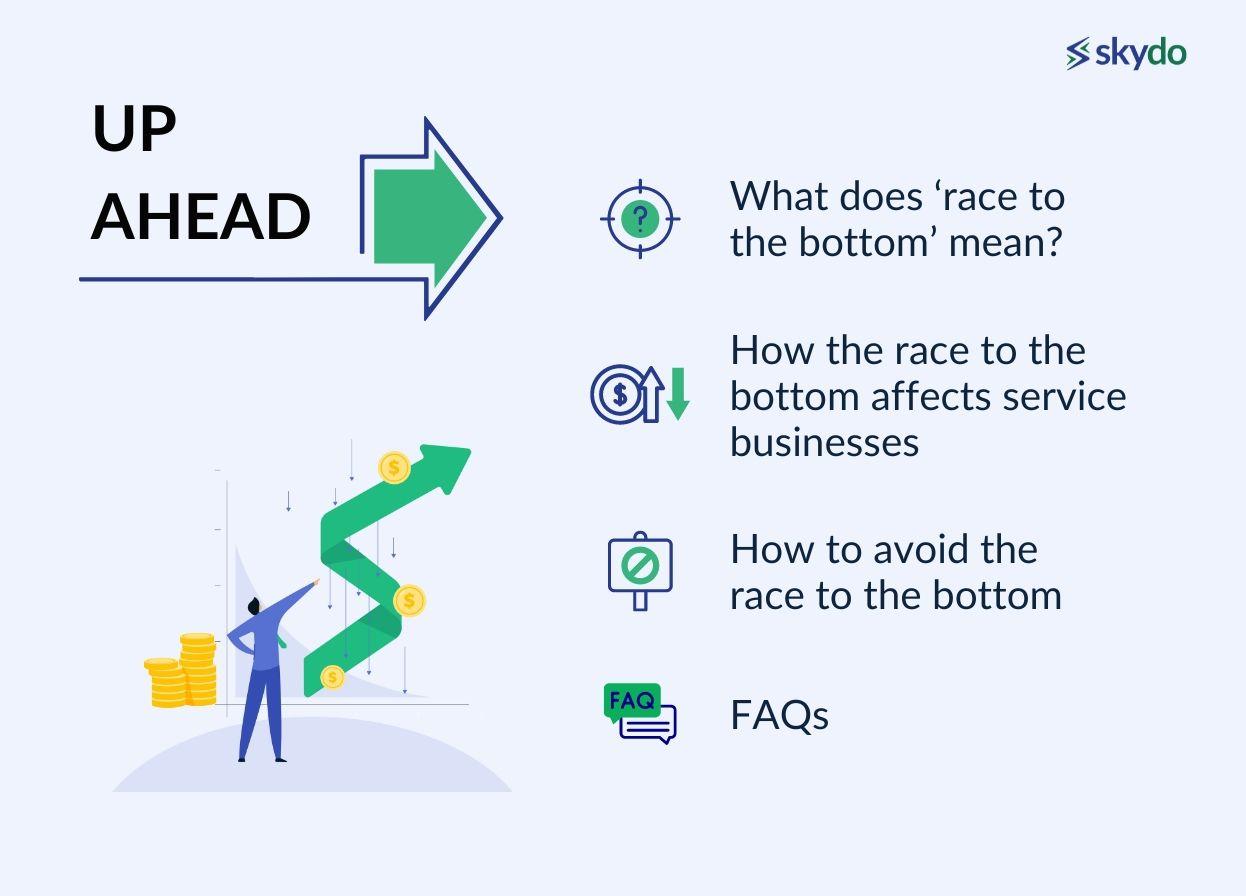

Imagine stepping into the shoes of Priyanka, a small bakery owner in Bandra, Mumbai. It's the third quarter of 2020, the COVID-19 crisis has hit hard, and the bakery is feeling the heat. Competitors are slashing prices, and cash flow is becoming a significant concern.
Her fears of losing to competition and changing market conditions seem to be manifesting right before her eyes. However, Priyanka had a different approach in mind. Instead of joining the race to the bottom with price cuts, she focused on enhancing the value she offered her customers.
Priyanka started introducing artisan bread and custom cakes and began holding weekend baking workshops, elevating her bakery from just a store to a community space. Her customers loved the new offerings and the chance to learn from a seasoned baker. Her bakery became more than just a place to buy bread—it became a place of experience, a place where people felt valued.
Fast forward to today, Priyanka's bakery stands strong even as many of her early competitors have closed their doors.
According to a study by McKinsey & Company, this value-centric approach puts Priyanka on the right track. Businesses that focus solely on price tend to have lower business margins and are more likely to fail than those that focus on creating value for their customers.
The study also found that businesses focusing on value creation are more likely to succeed and exceed gross profit margins by more than 26%, making their employees happier and simplifying their end-to-end operations1.
As a service provider, you have the power to differentiate yourself, much like Priyanka did, by delivering high-quality services that provide value to customers and investing in technology and innovation.
But, What Does ‘Race to the Bottom’ Mean?
The "race to the bottom" is when companies compete with each other by lowering prices, often at the expense of quality and employee well-being, to win market share. This approach can lead to a downward spiral where companies continually cut costs to remain competitive, degrading the standards and a race to the lowest possible price point.
This practice has been around for centuries, with roots in the industrialisation and globalisation of economies.
How the Race to the Bottom Affects Service Businesses
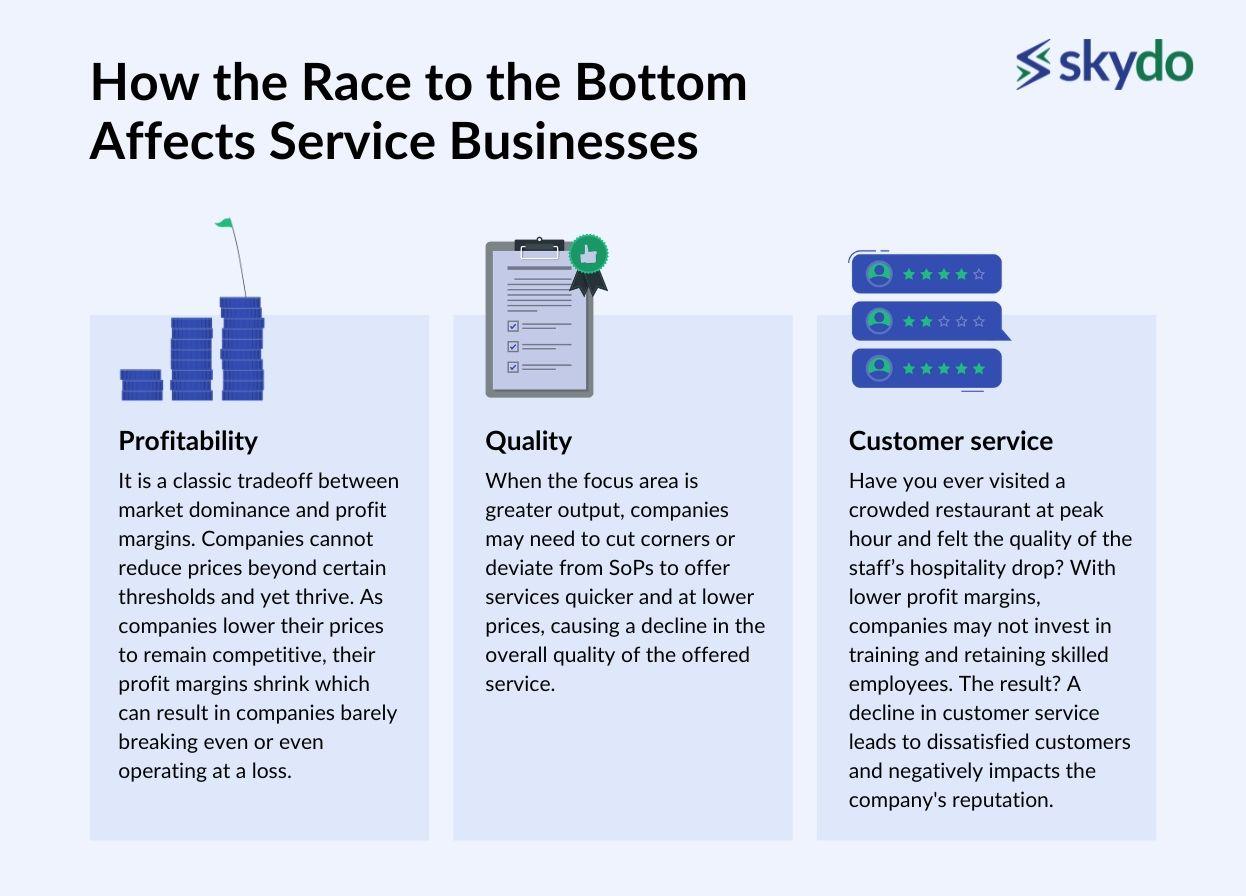
- Profitability: It is a classic tradeoff between market dominance and profit margins. Companies cannot reduce prices beyond certain thresholds and yet thrive. As companies lower their prices to remain competitive, their profit margins shrink which can result in companies barely breaking even or even operating at a loss.
- Quality: When the focus area is greater output, companies may need to cut corners or deviate from SoPs to offer services quicker and at lower prices, causing a decline in the overall quality of the offered service.
- Customer service: Have you ever visited a crowded restaurant at peak hour and felt the quality of the staff’s hospitality drop? With lower profit margins, companies may not invest in training and retaining skilled employees. The result? A decline in customer service leads to dissatisfied customers and negatively impacts the company's reputation.
The airline industry has many low-cost carriers offering lower prices at the expense of quality and customer service. One of the cheapest airline companies in the country- Go First, had upsetting customer service in terms of punctuality and maintenance. The cheaper flight tickets compromised on quality experience and slim margins have led the company to file for voluntary bankruptcy in May of 2023.
How to Avoid the Race to the Bottom
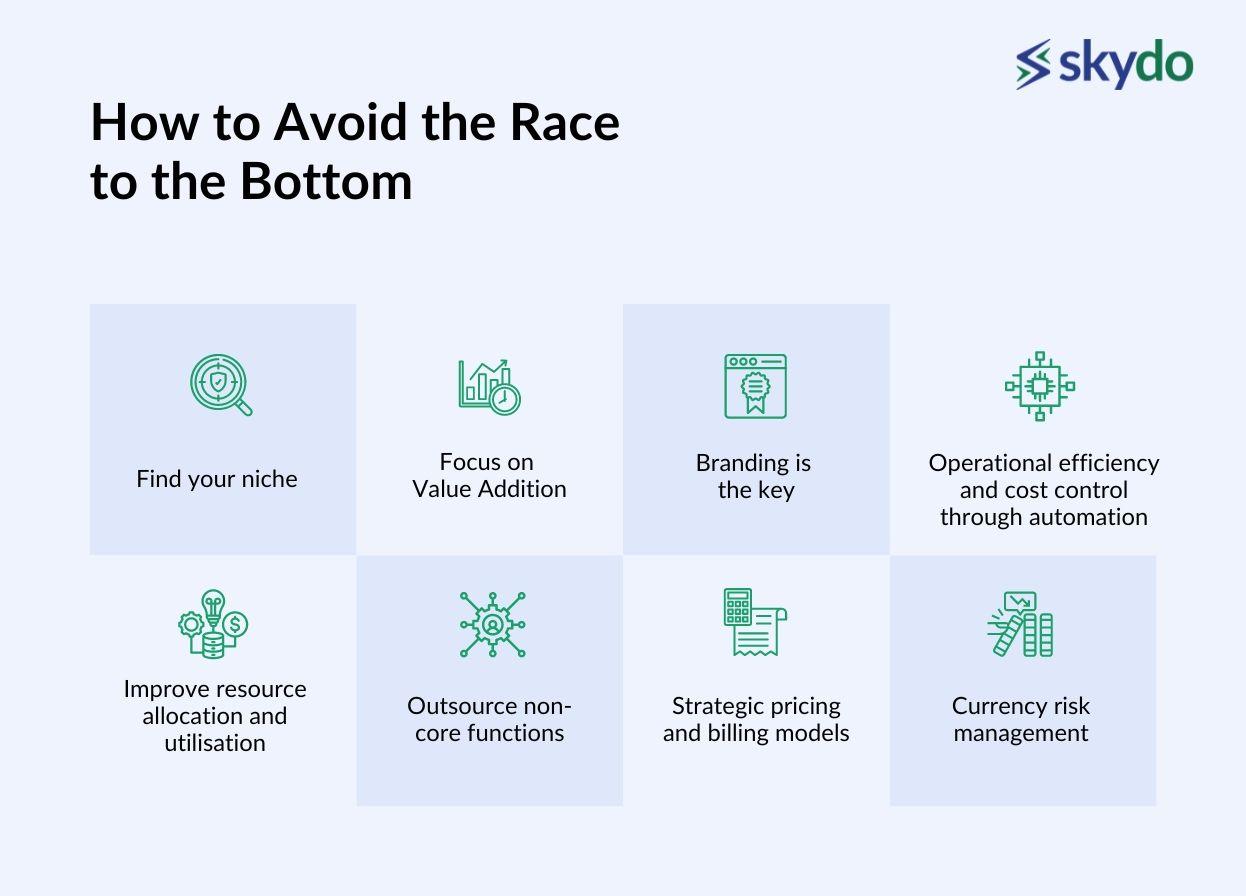
1. Find Your Niche
Be a bigger fish in a smaller pond than a smaller fish in a big pond. By specialising in a particular area, you can position yourself as an expert and charge a premium for your services.
For instance, instead of offering generic web design services, you could specialise in creating visually stunning websites for eco-conscious businesses. This way, you establish yourself as an expert in that niche, allowing you to command higher prices and attract clients who value your specialised expertise.
2. Focus on Value Addition
It’s less about what you do, and more about what the customer gets from what you do. Focusing on value rather than price is essential for service businesses to differentiate themselves from competitors and avoid the race to the bottom.
According to Hubspot, a 5% increase in customer retention can lead to a 25% to 95% increase in revenue. It demonstrates the importance of providing unique value to customers to retain their business over the long term.
You can focus on value-addition to your customers through:
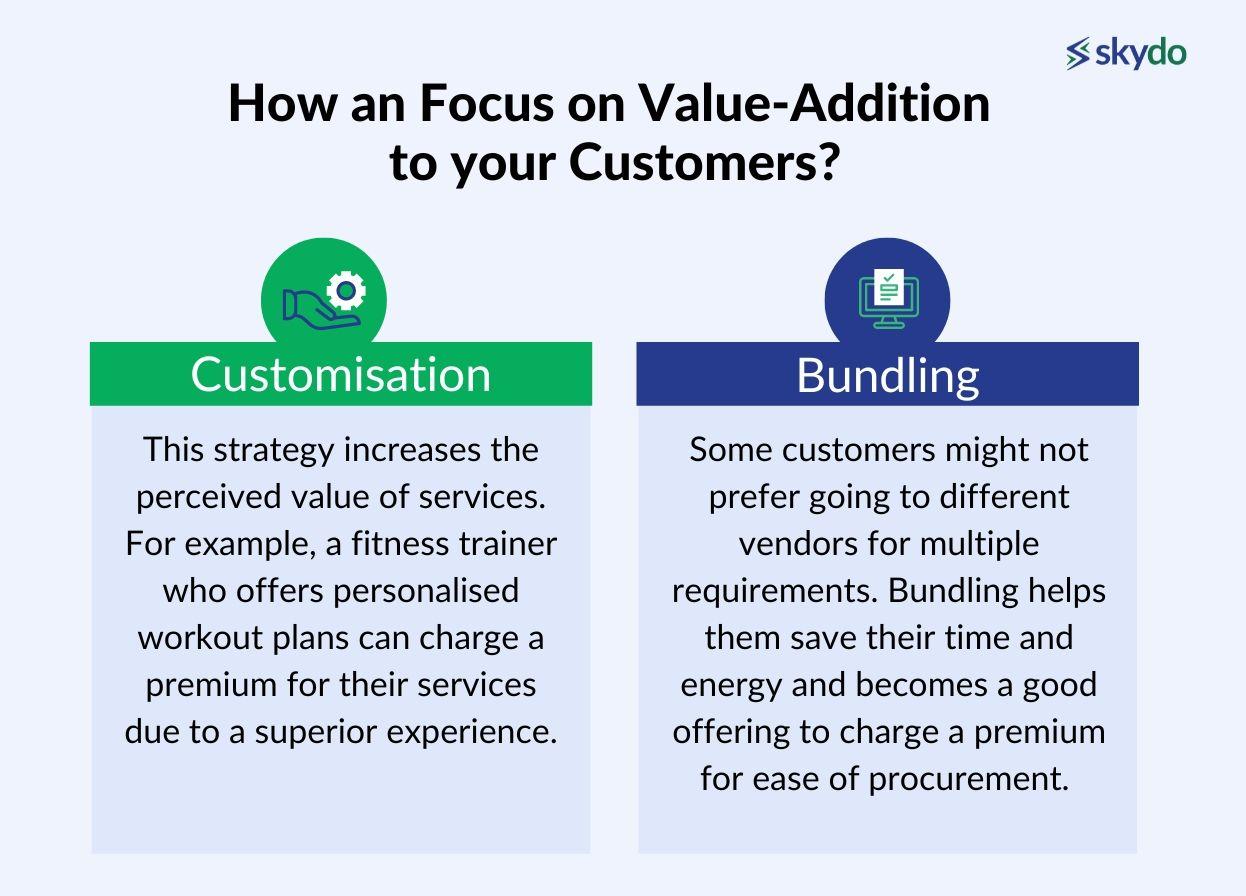
- Customisation: This strategy increases the perceived value of services. For example, a fitness trainer who offers personalised workout plans can charge a premium for their services due to a superior experience.
- Bundling: Some customers might not prefer going to different vendors for multiple requirements. Bundling helps them save their time and energy and becomes a good offering to charge a premium for ease of procurement.
McDonald's avoids the race to the bottom by offering bundled value meals instead of individual items. This strategy increases the average order value and enhances customer satisfaction by providing a complete dining experience. By maintaining profit margins through bundled pricing, McDonald's delivers convenience, and value, and sustains profitability while avoiding price competition.
3. Branding is the key
As much as products need marketing, services need strong branding. Branding is the process of creating a distinct identity for a product, service, or company to shape consumer perception and reputation. It goes beyond visual elements, encompassing values, personality, and emotions associated with the brand.
The service industry is built on trust and a strong brand helps you gain that trust. A study by Forbes found that consistent branding can increase revenue by up to 23%.
The collaboration between DHL, a global logistics leader, and Coldplay, an internationally acclaimed band, stands as a shining example of successful branding through sustainable logistics. By aligning their values, implementing sustainable tour logistics, neutralising carbon emissions, engaging fans, and building trust, they achieved not only environmental milestones but also forged a deep connection with their audience.
Similarly, personal branding helps strengthen a level of trust with your audience and vouches for the quality of services you provide as a freelancer, entrepreneur, or content creator. For example, Gary Vee, Chris Do, and Ankur Warikoo, have built such a powerful relationship with their audience that selling their courses or merchandise has become much easier for them than for someone with no personal brand.
4. Operational efficiency and cost control through automation
As a service provider looking to improve profitability, your focus should be cost-cutting, not price-cutting.
In a world with over 100,000 SaaS tools (many of them completely free), and a growing application of Artificial Intelligence and Machine Learning, streamlining your processes and improving operational efficiency with automation tools is imperative.
For instance, the talk of the town, ChatGPT, can help service-based companies automate tasks, providing 24/7 customer support, analysing data, as well as optimising mobile experiences. It saves time, energy, and overhead costs all at once.
Did you know? Walmart used blockchain technology in its food supply ecosystem. As a result, the time needed to trace mangoes’ provenance went from 7 days to 2.2 seconds!
5. Outsource non-core functions
This strategy includes delegating functions such as accounting, HR, or IT to specialised firms that can provide these services more efficiently and cost-effectively. This way, you spend less time and money hiring & training for non-core jobs.
The banking industry has made it easier for customers to engage with virtual relationship managers (VRMs) without having to visit the branch.
Similarly, Amazon is known to outsource its customer services to increase its bottom line. Outsourcing means no extra benefits, paid leaves, or insurance to employees, thus making it cost-effective and efficient.
6. Strategic pricing and billing models
Setting the right price for your services can be challenging. If you price too high, you may lose customers to competitors. If you price too low, you risk devaluing your services, ultimately hurting your profit margins.
Some strategies that service businesses can use to implement effective pricing and billing models include:
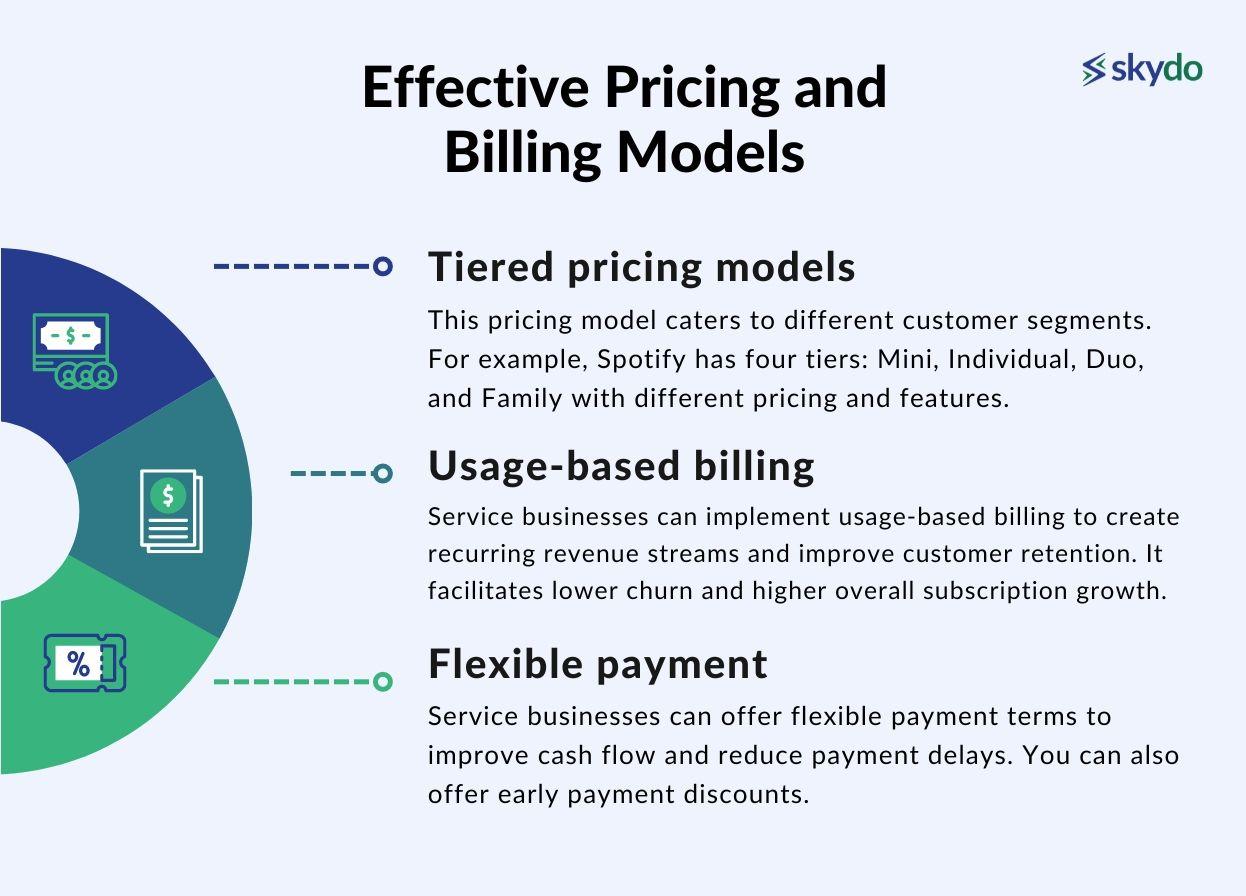
- Tiered pricing models
This pricing model caters to different customer segments. For example, Spotify has four tiers: Mini, Individual, Duo, and Family with different pricing and features.
Bryan Harris, founder of the Growth Tool after the launch of his “Get 10,000 Subscribers” in 2015 said, “Tiered pricing has accounted for 25% of all of our revenue over the last 18 months.”
- Usage-based billing
Service businesses can implement usage-based billing to create recurring revenue streams and improve customer retention. It facilitates lower churn and higher overall subscription growth.
According to Dr Carl Gold, Chief Data Scientist at Zuora, “Companies in industries like publishing that do not adopt usage billing generally have higher churn than companies like those in SaaS or Business Services that do. This suggests that the balance and flexibility of usage-based pricing plays a useful role in customer engagement and retention.”
- Flexible payment
Service businesses can offer flexible payment terms to improve cash flow and reduce payment delays. You can also offer early payment discounts.
82% of UK B2B buyers say that they’re more likely to buy online from a business if they offer flexible payment options.
Yash Kirti Gandhi, a freelance motion designer providing services for around 7 years, suggests, “It’s a good strategy to add accountability with a prospective client. For example, if the payment term suggests 50% advance payment and the rest on project completion, it makes them feel safer about their spending and gives the client a sense of control over their money. However, the long-term association would only depend on the value you provide.”
7. Currency risk management
Payment terms and currency risk management are closely intertwined, as both impact the cash flow of your business. Understanding how to manage currency risk and set payment terms that align with your business goals can help you navigate the complexities of international business and safeguard your profits.
For example, If your costs are denominated in one currency and your revenue in another, fluctuations in exchange rates can significantly impact your profitability. By using hedging strategies or pricing your services in the same currency, you can mitigate this risk and avoid being forced to lower your prices to compete.
Conclusion
Protecting business margins in service businesses is crucial for long-term success and profitability. It is up to you to prioritise charging fair market value or offering competitive pricing to attract customers. Strategise your offerings with the correct pricing without hurting your margins.
Remember that the race to the bottom can negatively affect businesses and the industry, including losing quality and reputation. Therefore, focus on delivering high-quality services that provide value to customers rather than competing solely on price.
FAQs
Q1. How can businesses differentiate themselves without relying on price cuts?
Ans: Businesses can differentiate themselves by focusing on value addition rather than competing solely on price. Offering unique services, personalised experiences, and innovative solutions allows businesses to stand out and attract customers who value quality over low prices.
Q2. What role does branding play in safeguarding business margins?
Ans: Strong branding is essential for businesses looking to avoid the race to the bottom. A well-established brand helps build trust, loyalty, and perceived value, allowing businesses to command fair market prices based on their reputation and the quality of their offerings.
Q3. What are some practical strategies for strategic pricing?
Ans: Strategic pricing involves methods such as tiered pricing models, usage-based billing, flexible payment terms, and currency risk management. These strategies help businesses set appropriate prices, attract a diverse customer base, and ensure long-term profitability without compromising on value.
Q4. What role does customer retention play in safeguarding business margins?
Ans: Customer retention is essential for safeguarding business margins. Studies show that a small increase in customer retention can lead to a significant increase in revenue. By providing unique value and maintaining customer loyalty, businesses can avoid the downward pressure on prices.




